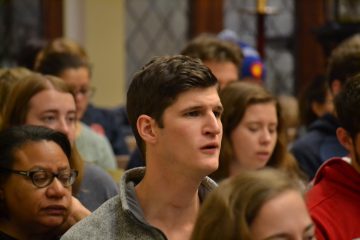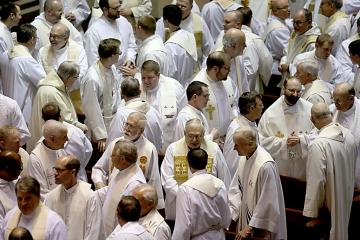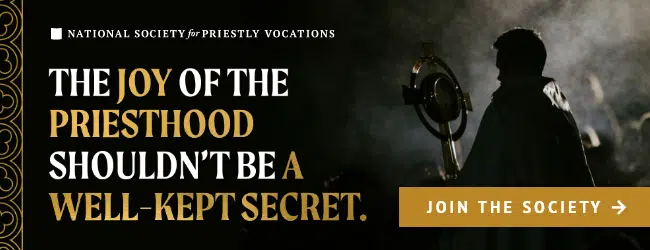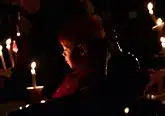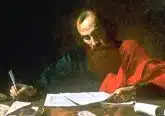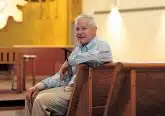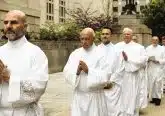Vocations and the Catholic Impulse of “Both/And”

For several years, many of us Catholics in the Archdiocese of Cincinnati have been including in Mass a prayer for vocations, written by Archbishop Emeritus Dennis M. Schnurr shortly after his move to Cincinnati. I must confess that, initially, I mildly resisted the general theme of this prayer. This is not because I disagree with any of the very good things we seek in this prayer. Rather, my initial reticence pertained to the prayer’s broad scope applied to the concept of “vocation.” While I have lowered my resistance, the reason behind my initial hesitation is instructive for how we think about vocations. At first, I mistakenly thought of vocations in an “either/or” mindset, rather than a “both/ and” understanding. The prayer for vocations helped me overcome this mistake.
I had wanted to reserve the term “vocation” for people in ordained or consecrated life. Of course, it is good to pray that single people be chaste and that husbands and wives be faithful to one another. But is a chaste single life a “vocation”? Is a faithful marriage? I was inclined to say no: while I desire these goods for all persons, I did not consider them to be vocations. After taking a closer look at the prayer, however—and Catholic life more generally—I have come to embrace these modes of life as vocations.
Ordination and Consecration
It is common for us to think that vocations pertain primarily, if not exclusively, to ordained or consecrated religious life. In fact, when we Catholics say someone has a vocation, we universally understand that to mean a vocation to the priesthood for men or religious life for women. Very rarely, if ever, do we refer to “the vocation of marriage or single life” in our normal conversations. This is neither surprising nor wrong.
In Matthew 16:19, Jesus said to the apostle Peter, “I will give you the keys of the kingdom of heaven, and whatever you bind on earth shall be bound in heaven, and whatever you loose on earth shall be loosed in heaven.” This is the introduction of ordained priestly vocation as a distinct office in the life of the Church; Peter had a unique place in the teaching hierarchy, including the authority to interpret and promulgate binding doctrine. In Matthew 18:18, Jesus extended the exercise of this authority to the rest of the Apostles and their successors. In the context of teaching about the procedures for Church discipline, Jesus told the Apostles, “Truly I say to you, whatever you bind on earth shall be bound in heaven, and whatever you loose on earth shall be loosed in heaven.” Recognizing this vocational mandate, the Apostles later ordained deacons (Acts 6:3-7) and, as when they replaced Judas with St. Matthias, their own priestly successors (Acts 1:15-25). This is the foundation for the Catholic understanding of the magisterium as a distinct “vocation” in the life of the Church. It is reiterated in Acts 14:23, Romans 15:16, 1 Timothy 5:17, Titus 1:5 and James 5:14-15.
However, as I considered the prayer for vocations, I came to appreciate the legitimacy of a broader definition of vocation, so long as we maintain the unique identity of ordained and consecrated life.
Priesthood of all Believers
The First Epistle of St. Peter admonishes all Christians, “Like living stones be yourselves built into a spiritual house, to be a holy priesthood, to offer spiritual sacrifices acceptable to God through Jesus Christ” (1 Pt. 2:5). This is because, the author adds, “You are a chosen race, a royal priesthood, a holy nation, God’s own people” (1 Pt. 2:9). This is the basis for what the Vatican II document Lumen Gentium (LG) calls the “priesthood of all believers.” “Though they differ from one another in essence … the … priesthood of the faithful and the ministerial … priesthood are … interrelated: each of them in its own special way is a participation in the one priesthood of Christ.” The lay faithful “exercise that priesthood in receiving the sacraments, in prayer and thanksgiving, in the witness of a holy life, and by self- denial and active charity” (LG, 10).
Because we are baptized into Christ, we are initiated into a share of his ministry, including his priestly ministry. This is why, for example, the rite of baptism includes anointing with the chrism oil, which is symbolic of the consecration of prophet, priest, and king. While distinct in “essence” from ordained priesthood, we lay people have a role in Christ’s priesthood through participation.
This is different from priestly vocation but important, nonetheless.
Vocation as Witness
Finally, the prayer for vocations teaches us that we all have a vocation to witness to the Good News of salvation. “Faithful husbands and wives” are “a sign of Christ’s love for his Church” because the “vocation” is not marriage, per se, but rather the witness to the fidelity and joy of the Gospel through faithful, fruitful marriage. Chaste marriage is an image of Christ’s faithful devotion to us, and thus, married couples have a vocation to communicate that sign. To summarize this, 1 Peter tells us, “You are … God’s own people, that you may declare the wonderful deeds of him who called you out of darkness into his marvelous light” (1 Pt. 2:9).
By expanding our notion of vocation, we can simultaneously maintain the unique place of ordained and consecrated life, while affirming the lay people’s role in the priestly ministry of Christ and our witness to the joy of salvation. ✣
 Dr. Kenneth Craycraft holds the James J. Gardner Chair of Moral Theology at Mount St. Mary’s Seminary & School of Theology. He is the author of Citizens Yet Strangers: Living Authentically Catholic in a Divided America.
Dr. Kenneth Craycraft holds the James J. Gardner Chair of Moral Theology at Mount St. Mary’s Seminary & School of Theology. He is the author of Citizens Yet Strangers: Living Authentically Catholic in a Divided America.
This article appeared in the November 2025 edition of The Catholic Telegraph Magazine. For your complimentary subscription, click here.



![The night is advanced, the day is at hand. Let us then throw off the works of darkness [and] put on the armor of light Romans 13:12 Rorate Mass Old St Mary (CT Photo/Greg Hartman)](https://www.thecatholictelegraph.com/wp-content/uploads/2018/12/DSC_0569a-360x240.jpg)
